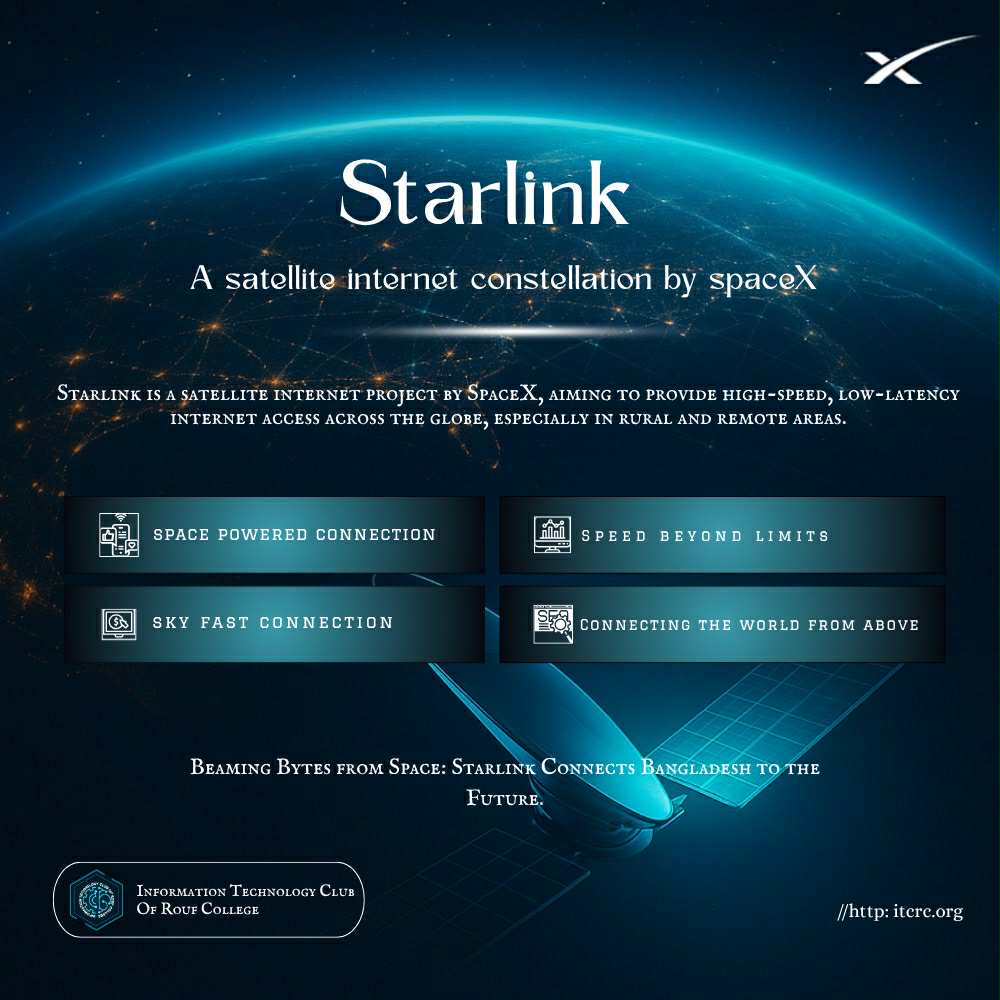Starlink in Bangladesh: A Digital Revolution

Tarannum Fariha
Rahman Nuram Mubina Hridee
Starlink, founded by Elon Musk, is an internet service operated via satellites by SpaceX. Like any other technology, it offers an unparalleled, fast, and efficient means of internet access through satellites instead of cables, delivering connectivity directly to users. This is achieved with the help of thousands of satellites placed in Low Earth Orbit (LEO), at altitudes ranging from roughly 340 km to 1,200 km.
The greatest advantage of Starlink satellite internet is its automated technology and broad coverage area. It provides internet access to regions without connectivity or mobile networks, where traditional optical fiber is unavailable. The service is delivered through a self-installable dish and a router, which together offer high-speed satellite internet with low latency.
—
How it Works
Most traditional satellite internet services rely on a single large satellite located far out in space—about 35,786 km above Earth. Due to this long distance, data transmission takes a long time, causing significant delay, or latency, which disrupts activities like video calls, online gaming, and streaming.
Starlink works differently. Instead of one distant satellite, it uses thousands of small satellites flying much closer to Earth—only about 550 km high. Because of this proximity, data travels much faster, with significantly lower latency (around 25 milliseconds compared to over 600 ms). This makes video chatting, gaming, and streaming much smoother.
SpaceX plans to launch up to 40,000 satellites in the future to cover the entire globe—even remote areas—and reduce internet interruptions.
Since SpaceX also owns the rockets, it can launch new satellites regularly. Other companies often struggle with this due to the high cost of satellite launches.
—
Starlink in Bangladesh: A Big Step Forward
By the end of 2024, Starlink received approval to start its services in Bangladesh and began trials in early 2025. This marks a significant milestone in the country’s digital future.
Fast internet is no longer limited to cities—it’s reaching remote villages as well. Students, workers, and small business owners in rural areas can now join online classes, work remotely, shop or sell online, use digital banking, and access government services more easily.
Starlink is helping bridge the gap between urban and rural areas. It’s opening new doors for education, healthcare, and employment. Young people from any corner of the country can now work for international companies without having to migrate.
—
Understanding Starlink: What It Really Offers—And What It Doesn’t
Many people are curious about Starlink but hold common misconceptions. Let’s clear some of them up.
Can I get Wi-Fi on my phone anywhere in the country with Starlink?
No, it doesn’t work like that. Starlink does not create a giant, invisible Wi-Fi network across the country. To use it, you need specific equipment: a satellite dish, a Wi-Fi router, and electricity—all set up in a fixed location. It’s not like 4G or mobile data where your phone connects automatically. So, if you’re planning to scroll Instagram from a mountain in Bandarban, that won’t work—unless you bring along the dish, router, power supply, and a solid table. Yes, people have tried!
Will Starlink work even if the government shuts down the internet?
Not really. Even though Starlink uses satellites, it must comply with Bangladeshi regulations. To operate here, Starlink signed agreements with the government, which includes allowing the government to suspend or shut down the service if needed—during unrest or emergencies. So if all local networks go offline, Starlink can be taken offline too.
Do the satellites stay in space forever?
No. Starlink satellites are designed to last in space for about 5 to 7 years. After that, they burn up in the atmosphere. So even the satellites that power your internet are temporary.
—
Starlink: A Game Changer for Bangladesh
Starlink has the potential to be a game changer. This satellite internet service can connect remote regions of Bangladesh that traditional services cannot reach.
In the education and development sector, NGOs can use Starlink to run digital health programs. For public health and safety, rural clinics can offer telemedicine, and emergency teams can stay connected during natural disasters.
In business and tourism, banks and delivery services in remote areas can finally have fast, stable internet. Even government services—such as voter registration and smart rural monitoring—become easier with reliable connectivity.
Though Starlink is expensive for most individuals, it has two plans in Bangladesh: Tk 6,000 or Tk 4,200 per month. The one-time setup cost is Tk 47,000. While costly, it’s worthwhile for rural development, disaster response, and institutional uses.
However, if you live in areas like Gulshan, Dhanmondi, or Savar—where fiber internet is already reliable—Starlink may not be necessary. Regular broadband is usually more stable and cost-effective there.
—
As the sun sets over the quiet villages of northern Bangladesh, something has changed. The internet, once sluggish and limited, is now fast, reliable, and unlimited. The arrival of Starlink marks a remarkable moment in Bangladesh’s digital journey. It’s more than just a technological upgrade—it’s the start of a transformative chapter in the nation’s story.
To fully realize its potential, Bangladesh must adopt a thoughtful and strategic approach: robust data protection laws, strong regulatory frameworks, cybersecurity safeguards, and international cooperation. Only then can this digital revolution become a lasting force for national progress.
